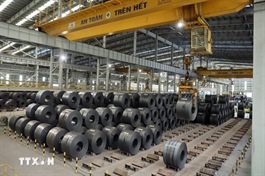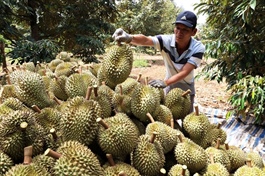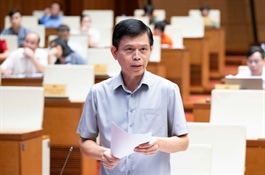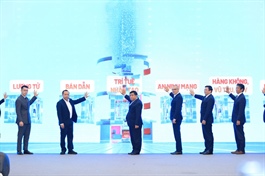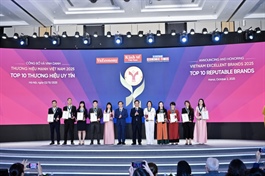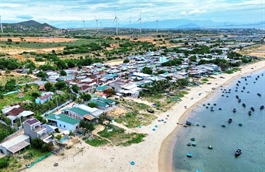World Bank charts talent path for Vietnam’s semiconductor future
World Bank charts talent path for Vietnam’s semiconductor future
The World Bank has proposed a 'three-plus-one' formula to help Vietnam develop its semiconductor industry and other high technologies, calling for a strong long-term strategy.
|
Launch of the World Bank’s report on talent and innovation for Vietnam’s semiconductor industry, October 2 |
At a forum on innovation in strategic technology sectors on October 2, the World Bank released a report on talent and innovation for Vietnam’s semiconductor industry. The report noted that landmark reforms, particularly Resolution No.57-NQ/TW, reflect Vietnam’s commitment and determination to advance into high-tech industries.
"Vietnam has real advantages. A young, talented workforce. Macroeconomic stability. A strategic location in Asia's growth corridor. And a proven ability to learn and adapt. What we need now is the right strategy," said Mariam J. Sherman, World Bank country director for Vietnam, Cambodia, and Laos.
According to the World Bank, the 'three-plus-one' formula centres on building a skilled workforce and top tech talent, developing an innovation ecosystem that connects academia, domestic and foreign firms, and the government, and strengthening supply chain linkages. The “plus one” is a sharp focus on a few targeted clusters of innovation excellence to anchor Vietnam’s technological progress.
On talent, Sherman stressed that Vietnam must boost both the number and quality of graduates, while producing more world-class technicians, scientists, and engineers. Universities need more investment to train talent and drive research, while vocational colleges should work hand-in-hand with businesses to supply the skilled technicians high-tech industries demand.
"Attracting and retaining talent matters as much as developing talent. Nearly 65 per cent of Vietnam's top tech talent in critical and emerging technologies currently work overseas. Creating the right conditions for this talent to return and thrive in Vietnam can close knowledge and network gaps that might otherwise take decades to fill," she said.
"In short, investing in people is fundamental. It's what drives sci-tech forward and gives firms confidence that the right talent will be there at every level, from skilled technicians and engineers to visionary scientists and leaders," she added.
Building a strong innovation ecosystem mean bringing together academia, government, and both local and foreign firms. It's an ecosystem where research can flourish, where ideas move from lab to market, and where startups can scale into homegrown unicorns.
Vietnam has laid important groundwork. Yet, higher-value work, like product design, engineering, and turning research into commercial products, is still in its early days. To give an example, from 2010 to 2020, Vietnam filed fewer than 100 patents in the top five international patent offices, with virtually none in semiconductors. This is where the opportunity for growth lies.
"Boosting public and private investment in research and innovation is critical, especially in infrastructure for research and development (R&D). Breakthroughs in high-tech require research labs, prototyping and pilot lines, and advanced training centres," said Sherman.
The World Bank is urging Vietnam to establish national semiconductor design hubs – world-class centres where universities, researchers, and startups can share access to advanced computing, design libraries, and prototyping tools to test chips before commercial production.
According to Sherman, "These hubs speed up innovation and give students and scientists hands-on experience to turn designs into reality."
To unlock Vietnam’s full innovation potential, the Bank stresses the need to strengthen the 'triple helix' partnership of academia, industry, and government. In leading global hubs, universities drive research and talent, firms scale innovation, and governments link the pieces – a model already proven across 33 East Asian science and tech clusters in the world’s top 100.
|
Mariam J. Sherman, WB country director for Vietnam, Cambodia, and Laos |
As for deepening ties between Vietnam's domestic companies, especially small- and medium-sized enterprises (SMEs) and large oversea firms, the goal is straightforward – to help Vietnamese companies capture more value from global supply chains by moving from simple suppliers into trusted co-innovators and long-term partners of multinationals.
"To make this happen, a collaborative partnership model, where international and Vietnamese companies formally co-invest alongside the government to upgrade the capabilities of local firms, is essential," Sherman said.
This approach draws on proven global models. In Singapore, the Partnership for Capability Transformation matches multinational spending with SME upgrades through supplier development and joint R&D. Ireland runs a national buyer-supplier scheme that pairs global buyers with local firms and co-finances improvements.
Sherman suggested Vietnam could adopt a similar path, with foreign firms mentoring local SMEs to meet international standards on quality, delivery, and certification, supported by government funding tied to results. Such schemes could also co-finance projects to test prototypes or localise key parts, opening direct entry points into global production chains.
"We should start in sectors where Vietnam already has momentum: electronics, semiconductors, biotech, and pharmaceuticals," she said. "The payoff is clear: the knowledge stays and grows in Vietnam. Your companies win more business and climb the global value chain. And you build and keep a generation of highly skilled local talent."
And finally, the 'plus one' is the element that ties all the other three pillars together: to focus on a few well-chosen clusters of innovation excellence. China has built innovation corridors like the one connecting Shenzhen, Hong Kong, and Guangzhou. South Korea has its Daedeok Science Town. And Singapore has its dedicated innovation districts, like Fusionopolis and Jurong.
The world’s leading innovation hubs share a common DNA: flagship universities, joint university–industry science parks, R&D institutes, high-tech firms, innovative SMEs, ambitious startups, and major foreign investors.
In Vietnam, Sherman pointed to Hoa Lac High-Tech Park, which she said could evolve over the next decade into a centre for advanced manufacturing–spanning semiconductors, biomedicine, robotics, and automation. The cluster could unite universities, research institutes, training providers, and “factories of the future” into one ecosystem, making it possible to go from training and R&D to prototyping and full-scale production all in one place.
"Such clusters are powerful magnets for talent and ideas. They inspire young people in Vietnam to pursue careers in sci-tech, and they attract more of the Vietnamese diaspora to bring their skills and networks back home," she said.
This journey requires a whole-of-nation effort, with government, businesses, academia, and international partners each playing a vital role. The government sets the vision, creates enabling policies, and provides seed funding; universities work with industry to train the workforce and conduct R&D; and international partners contribute global expertise and financing.
"The World Bank is proud to be Vietnam's partner on this journey, building on more than 30 years of close collaboration. We are aligning our support to help Vietnam unlock its high-tech potential," Sherman said.
- 18:21 03/10/2025




